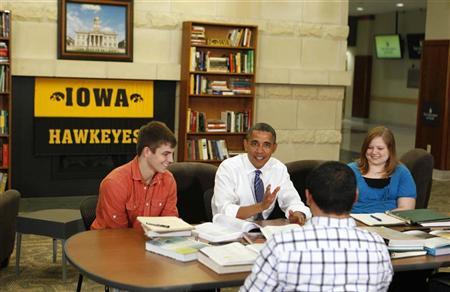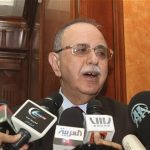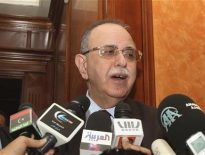(Reuters) – Elbot Carman, a 25-year-old aspiring
graphic designer, made so little money after earning his master’s degree last year that the U.S. government now says he can
hold off making payments on his school loans.

Carman owes $140,000 in a mix of government and
private student loans. Last year he earned $12,000.
“That was so low that they are not requiring me to make a payment
this year,” said Carman, who works a paid and an unpaid internship and recently moved back in with his mother in
Lawrenceville, Georgia to cut costs.
Carman signed up for a government program that helps indebted students by
limiting what they owe each month and, for some, forgiving their remaining balance after 10 or 25 years.
He is not
alone. As U.S. lawmakers consider how to keep interest rates on certain student loans from escalating, a growing number of
students have sought help through a bipartisan 2009 initiative. In less than three years, more than 675,000 borrowers have
signed up, according to the U.S. Department of Education.
Educators and policymakers also are looking for new
solutions to a mountain of student debt that has reached the $1 trillion mark. With a November 6 presidential election
looming, both President Barack Obama and his presumed Republican challenger Mitt Romney have targeted student loans as a
growing problem for American families and the struggling U.S. economy.
The average undergraduate leaves school today
owing nearly $29,000 and graduate students owe about $44,000, according to an analysis by Mark Kantrowitz, publisher of the
popular education financing websites FinAid.org and Fastweb.com.
Interest rates on subsidized federal Stafford student
loans, one of the main loans available to students, are set to double on July 1 unless Congress steps in to prevent it. On
Tuesday, Senate Republicans blocked a White House-backed bill that would end a tax break for the wealthy to fund an extension
of the lower rates, paving the way for possible compromise.
But that debate is aimed directly at middle class voters
more likely to cast a ballot this fall. The repayment programs are a wider effort to help cash-strapped
students.
Congress created the Income-Based Repayment Plan in 2007 to take some of the sting out of mounting student
bills. The Bush administration program, which finally began in 2009, limits struggling students’ payments to 15 percent of
their income and absolves debt after 25 years.
Students who become teachers, police officers and other public servants
could see their loans forgiven after 10 years.
In 2010, Obama signed into law a new plan to expand the forgiveness
program starting in 2014. Qualifying students with federal loans could see their payments capped at 10 percent of their
income, down from 15 percent, and forgiven after 15 years.
Last year, the administration tried to speed up that effort
through Education Department regulations. The “Pay as You Earn” proposal could widen the forgiveness programs by the end of
2012 – if U.S. education officials can pass the rule by November 1.
About 1.6 million borrowers could benefit over 10
years when that happens, according to department policy experts.
‘MUCH NEEDED RELIEF’
There’s little doubt
about the strain student debt creates on borrowers.
“As the amount of debt and interest rates increase, a greater
percentage of family income must be devoted to repaying student loans instead of other priorities,” said FinAid.org’s
Kantrowitz, whose unofficial Student Loan Debt Clock on Tuesday became the latest barometer to hit the $1 trillion
mark.
He says borrowers delay getting married, having kids and reaching other milestones. They also take longer to buy
big ticket items like cars or houses and delay saving for their own children’s college expense, continuing the cycle of
student debt, he adds.
Even Obama recently noted that he and First Lady Michelle Obama just finished paying off their
student loans eight years ago.
Spencer Pritchard, a 19-year-old college freshman, said his growing student debt
impacts the way he thinks about his future.
He just racked up $13,000 from his first year studying political economics
at the University of California at Berkeley. He had planned to work at a nonprofit, but now worries that he needs
higher-paying work.
“I kind of had the idea of going into the public service after this, but that’s going to be
difficult,” he said.
Education officials and other student debt activists say many more students qualify for
forgiveness programs – they just don’t know about them.
“I think it provides much needed relief for people,” said
Deanne Loonin, who oversees the National Consumer Law Center’s Student Loan Borrower Assistance Project, but “they’re very
underutilized.”
Compared to the 675,000 students on the income-based repayment plan, the effort in Congress to keep
some Stafford loan interest rates at 3.4 percent is estimated to affect 7.4 million borrowers.
Some lawmakers also are
pushing a House plan to expand loan forgiveness and interest rate caps. The Student Loan Forgiveness Act, sponsored by U.S.
Representative Hansen Clarke, a Michigan Democrat, would also allow students to roll private bank student loans into more
flexible, federal ones.
Still, critics point out that most students manage to repay loans without help. And there are
other options, they say.
John Boehner, the House of Representatives’ top Republican, said last month that he spent
seven years “working every job I could get my hands on” to pay for college.
Conservative columnist Cal Thomas wrote on
May 5: “If students and their parents choose expensive schools, they should accept the responsibility and cost accompanying
that decision.”
Carman said he’s grateful for a federal reprieve but still must tackle his private student loans.
Private lenders such as banks account for a significantly smaller portion of student loans in comparison to those available
from governments.
The real problem, he says, is rising college costs – which he wishes he had weighed before taking on
heavy debt.
“Ideally, student lending needs to die, it really does. It’s just not sustainable,” he
said.
(Reporting By Susan Heavey; Editing by Marilyn W. Thompson and Paul Simao)





